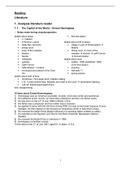Reading
Literature
1. Analysis literature reader
1.1. The Capital of the World – Ernest Hemingway
- Notes made during class/preparation
details about place: first-aid station
L1: Madrid
9 Pension Luarca details about shift of place:
Calle San Jeronimo village in part of Extremadura
dining-room Madrid
room of the matador dining room room of the
kitchen matador kitchen café Fornos
Seville first-aid station
Valladolid details about time:
upstairs written: 1936, published: 1938
Café Fornos (Civil War Spain)
Café Alvarez + terrace evening
moving-picture palace of the Gran half past 11
Via spring season
details about shift of time:
Christmas + first week April: matador selling
L10: 3 years before May: Matador and maid in the room remembers fighting
L25-33: flashforward death Paco
end: disappointing
10 facts about Ernest Hemmingway:
1) Hemingway was an American journalist, novelist, short-story writer and sportsman.
2) He publishes seven novels, six short-story collections and two non-fiction works.
3) He was born on the 21st of July 1899 in Illinois, U.S.A.
4) His father was a physician and his mother was a musician.
5) He applied to serve with the US Army during WWI, but was turned down because of poor
eyesight. He then signed on the become an ambulance driver in Italy (Red Cross).
6) He received the Italian Silver Medal of Bravery for assisting Italian soldiers to safety.
7) He reported on the Spanish Civil War for the North American Newspaper Alliance
(NANA).
8) He received the Nobel Prize in Literature in 1954.
9) Hemingway committed suicide.
10) He died on the 2nd of July 1961, aged 61, in Idaho, U.S.A.
1
,Analysing the story
WHO? CHARACTERS WHO NARRATOR(S) / POINT OF VIEW
Different questions you should try to answer: Different questions you should try to answer:
Reference to the real world Reference to the literary universe Reference to the real Reference to the literary
world universe
- Omniscient/all-knowing
Historic(al)/real characters or Flat or round characters? Do they develop or not? Why (not)? Historic(al)/real - Personal/through the eyes of a
not? Typical characteristics/traits? Details + examples from the text? characters or not? character/more characters
- I-narrator (unknown witness)
Who? (see time and place) Protagonist(s) versus antagonist(s)? Extras/unimportant characters? Who? (see time and - autobiographical narrator = author
Features/looks/other Narrators or not? place) (because of external evidence))
characteristics/attitude/quotation I/you/he/she/it/they/we
s
/ L8: Paco (protagonist) not a real character all-knowing
apprentice waiter third-person
wants to become a matador (status)
well-built, very black, curly hair, good teeth and skin, unpuzzled
smile, fast, worked well
flat character
poor village
L11: Paco’s two older sisters
chambermaids
beautiful and unsophisticated
L57: matador 1
ill and trying to conceal it
eating a little of all the dishes on the table, could not read, ate alone,
looked up very little
L57: matador 2
passed his short vogue as a novelty
very short and brown and very dignified, ate alone, smiled very
rarely, never laughed, old-fashioned, short
L58: matador 3
a coward
brave and skilful, jovial and laughed constantly, intelligent, open face
5
,L96: picador 1
thin, hawk-faced, grey hair, lightly build, always wore cattlemen’s
boots, drank too much, gazes amorously at any woman at the
pension
lost much of his ability (drink and dissipation)
L100: picador 2
huge, dark, brown-faced, good-looking, black hair like an Indian,
enormous hands
too headstrong and quarrelsome to stay with any matador more than
a single season
L107: banderillo
middle-aged, grey, cat-quick, intelligent and experienced, assured
and calm in the ring
L117: birthmarked-faced auctioneer of watches at the fairs
unimportant character
L119: two priests from Galicia
L128: the diners (extras)
L146: Ignacio
the tallest of the waiters
Anarcho-Syndicalist
politics
L149: the second waiter
man of fifty
L285: Enrique (protagonist)
the dishwasher
three years older than Paco
cynical and bitter
contributes to end
L378: other serious workmen (extras)
L383: two prostitutes (unimportant characters)
L389: the woman who owned the Luarca (unimportant)
big, fat, honest, clean, easy-going, very religious
L459: the doctor from the first-aid station
L460: a policeman
6
, What does the reader associate What is the effect of this on the story? What does the reader What is the effect of this
these real persons with? What What is the effect of the (lack of) this on the reader? associate these point of view on the story?
could an educated reader Which genre(s) do you as a reader associate this use of place with? “persons” with? What is the effect of point of
associate them with? view on the reader?
when the story takes place / full knowledge of all the
characters and situations
judges has negative
opinions
7




